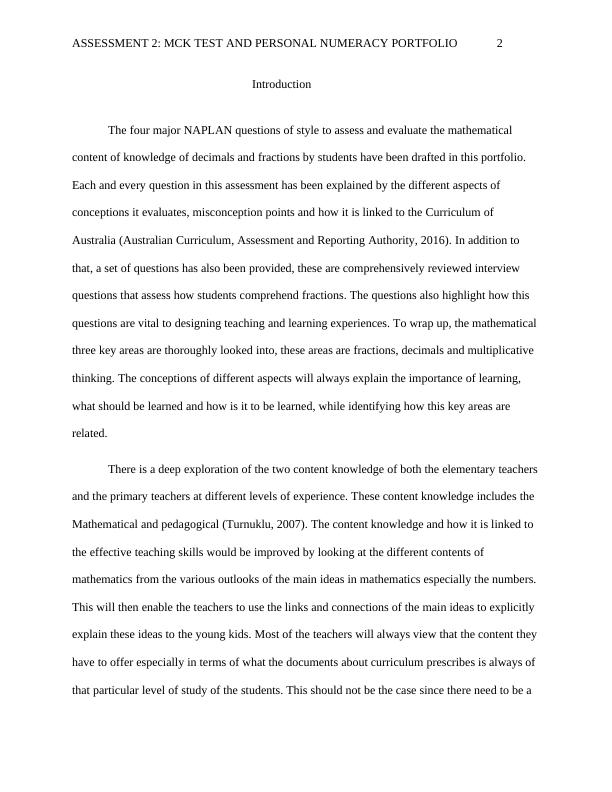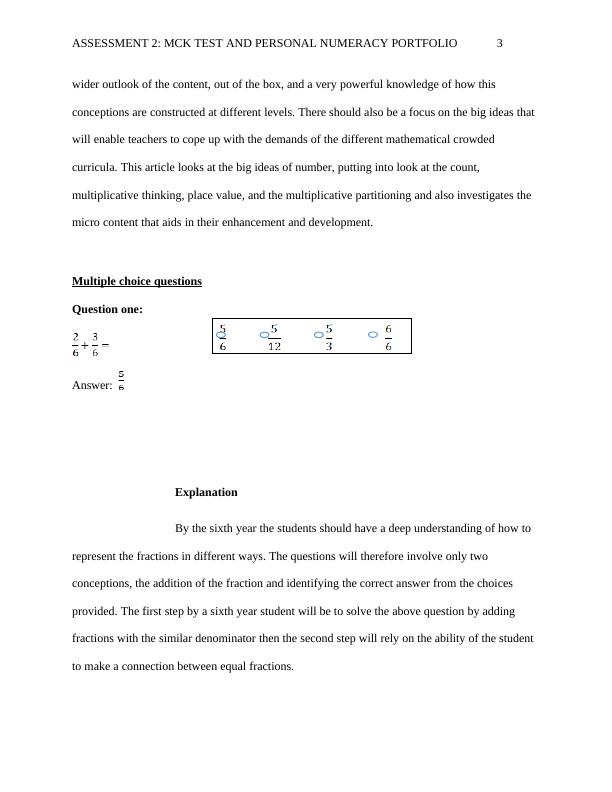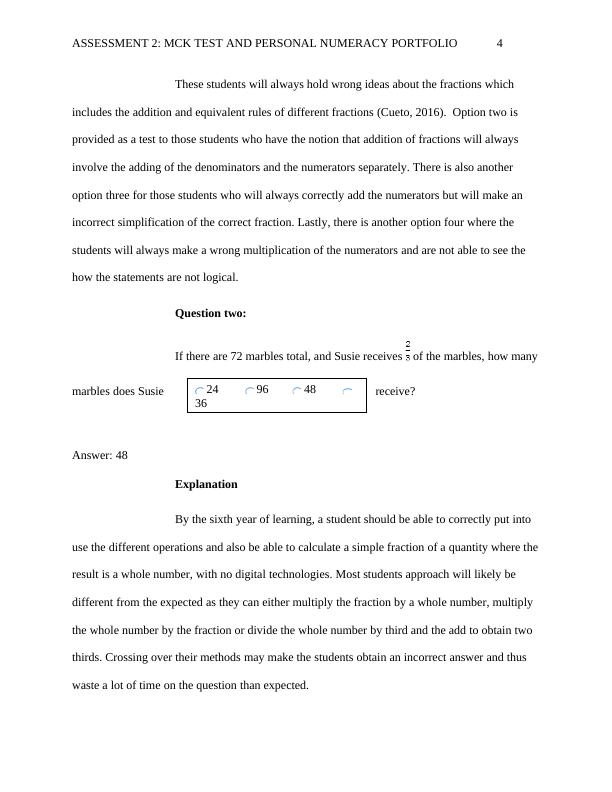EDP243 Children as Mathematical learners
20 Pages5521 Words471 Views
Curtin University
Children as Mathematical learners (EDP243)
Added on 2020-04-15
EDP243 Children as Mathematical learners
Curtin University
Children as Mathematical learners (EDP243)
Added on 2020-04-15
ShareRelated Documents
Running head:ASSESSMENT 2: MCK TEST AND PERSONAL NUMERACY PORTFOLIO1Assessment 2: MCK Test and Personal Numeracy Portfolio (Author’s name)(Institutional Affiliation)

ASSESSMENT 2: MCK TEST AND PERSONAL NUMERACY PORTFOLIO2IntroductionThe four major NAPLAN questions of style to assess and evaluate the mathematical content of knowledge of decimals and fractions by students have been drafted in this portfolio. Each and every question in this assessment has been explained by the different aspects of conceptions it evaluates, misconception points and how it is linked to the Curriculum of Australia (Australian Curriculum, Assessment and Reporting Authority, 2016). In addition to that, a set of questions has also been provided, these are comprehensively reviewed interview questions that assess how students comprehend fractions. The questions also highlight how this questions are vital to designing teaching and learning experiences. To wrap up, the mathematical three key areas are thoroughly looked into, these areas are fractions, decimals and multiplicative thinking. The conceptions of different aspects will always explain the importance of learning, what should be learned and how is it to be learned, while identifying how this key areas are related.There is a deep exploration of the two content knowledge of both the elementary teachersand the primary teachers at different levels of experience. These content knowledge includes the Mathematical and pedagogical (Turnuklu, 2007). The content knowledge and how it is linked to the effective teaching skills would be improved by looking at the different contents of mathematics from the various outlooks of the main ideas in mathematics especially the numbers. This will then enable the teachers to use the links and connections of the main ideas to explicitly explain these ideas to the young kids. Most of the teachers will always view that the content theyhave to offer especially in terms of what the documents about curriculum prescribes is always of that particular level of study of the students. This should not be the case since there need to be a

ASSESSMENT 2: MCK TEST AND PERSONAL NUMERACY PORTFOLIO3wider outlook of the content, out of the box, and a very powerful knowledge of how this conceptions are constructed at different levels. There should also be a focus on the big ideas that will enable teachers to cope up with the demands of the different mathematical crowded curricula. This article looks at the big ideas of number, putting into look at the count, multiplicative thinking, place value, and the multiplicative partitioning and also investigates the micro content that aids in their enhancement and development.Multiple choice questionsQuestion one: Answer: ExplanationBy the sixth year the students should have a deep understanding of how to represent the fractions in different ways. The questions will therefore involve only two conceptions, the addition of the fraction and identifying the correct answer from the choices provided. The first step by a sixth year student will be to solve the above question by adding fractions with the similar denominator then the second step will rely on the ability of the student to make a connection between equal fractions.

ASSESSMENT 2: MCK TEST AND PERSONAL NUMERACY PORTFOLIO4These students will always hold wrong ideas about the fractions which includes the addition and equivalent rules of different fractions (Cueto, 2016). Option two is provided as a test to those students who have the notion that addition of fractions will always involve the adding of the denominators and the numerators separately. There is also another option three for those students who will always correctly add the numerators but will make an incorrect simplification of the correct fraction. Lastly, there is another option four where the students will always make a wrong multiplication of the numerators and are not able to see the how the statements are not logical.Question two:If there are 72 marbles total, and Susie receives of the marbles, how manymarbles does Susiereceive? Answer: 48ExplanationBy the sixth year of learning, a student should be able to correctly put into use the different operations and also be able to calculate a simple fraction of a quantity where theresult is a whole number, with no digital technologies. Most students approach will likely be different from the expected as they can either multiply the fraction by a whole number, multiply the whole number by the fraction or divide the whole number by third and the add to obtain two thirds. Crossing over their methods may make the students obtain an incorrect answer and thus waste a lot of time on the question than expected. 24 96 48 36

End of preview
Want to access all the pages? Upload your documents or become a member.
Related Documents
Understanding Mathematics in Class 8 - Curriculum & Assessment in Secondary Teachinglg...
|20
|2951
|319
Analysis of Curriculum - Assignmentlg...
|8
|2464
|97
Teaching Equivalent Fractions in Mathematicslg...
|8
|2520
|418
Equivalent Fractions and Multiplication’s Factslg...
|3
|751
|415
Math 2A Unit 4: Process Numbers for Stage 6 Year 11-12lg...
|22
|3255
|176
Lesson Plan: Volume - Stage 4lg...
|20
|5048
|386
